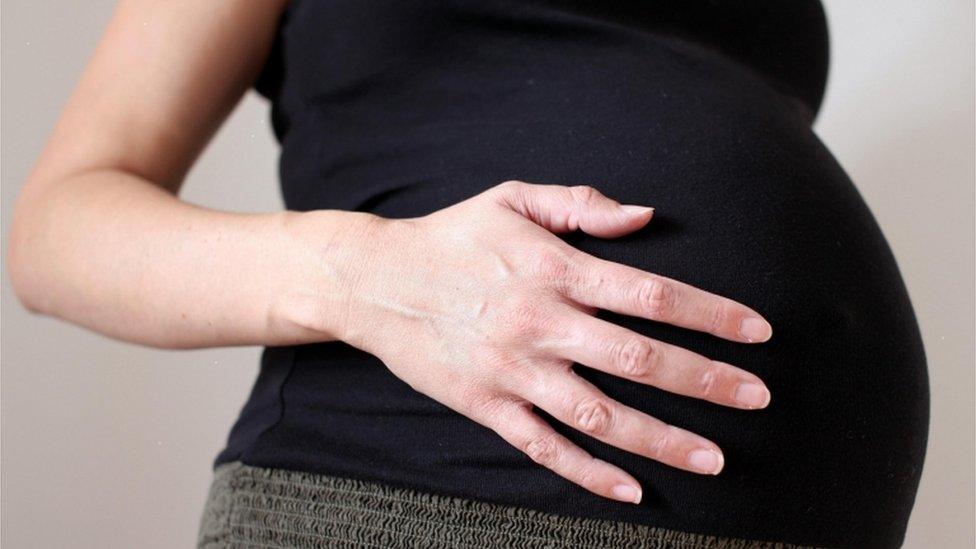Midwife units see one in four mums transferred to consultants
- Published
- comments
Catherine Buckley had to wait half an hour for an ambulance while she was giving birth
One in four women are transferred from midwife-led units to consultants because of complications when giving birth, an investigation found.
NHS bosses in England say stand-alone midwife units are as safe as doctor-led care for low-risk deliveries.
But the Birth Trauma Association said there was not enough data to support the claim for first-time mothers.
One woman told the BBC of an hour-long transfer from a midwife-led unit to another hospital.
BBC England's data unit contacted 139 hospital trusts, receiving information back about 128 midwife-led units in England under the Freedom of Information Act.
For more stories from the BBC England data unit follow our Pinterest board., external
It found:
A quarter of women who started their delivery in a midwife-led unit went on to be transferred to a consultant led ward
Fifty units would have to transfer women off-site if they required a consultant, with an average distance of 17 miles
Some of the longer distances travelled were in rural areas including Shropshire, Northumberland and Suffolk
Women giving birth at Berwick Infirmary in Northumberland would face a journey of up to 60 miles by ambulance if it is decided they need a consultant
The rate of women transferred from freestanding units was slightly lower, 22%, than for those sharing a site with a consultant-led ward, 28%
The National Institute for Health and Care Excellence (NICE) recommends midwife-led units for low-risk births, which is applicable to 45% of women.
It began to do so in December 2014 and said the rate of interventions - such as the use of forceps or epidurals - was lower and the "outcome for the baby is no different compared with an obstetric unit".
The Royal College of Midwives says women receive more personal care in a midwife-led unit.

"I was trying not to have my baby"
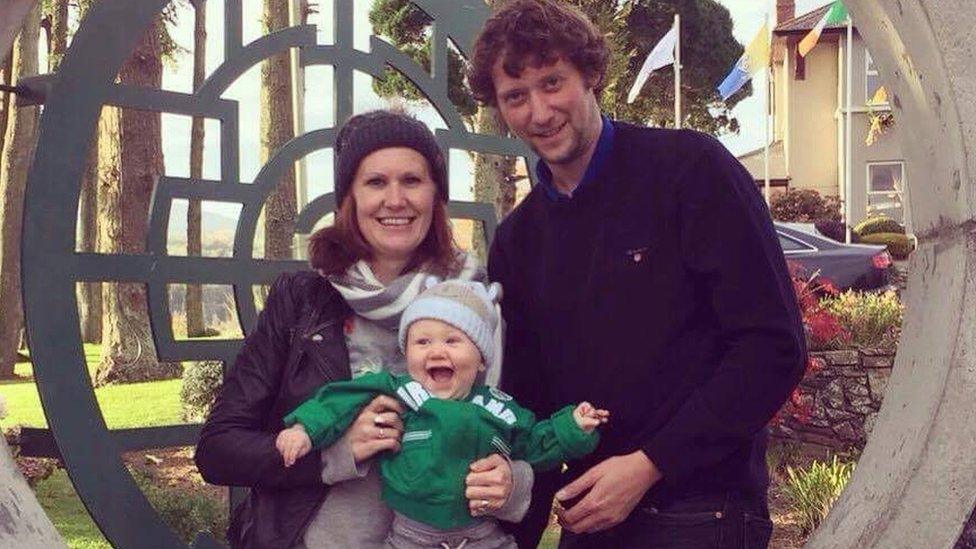
Catherine Buckley, with husband Jack, was transferred while giving birth to Ralph.
It should have taken 15 minutes to transfer Catherine Buckley from a midwife-led unit to the care of a doctor.
Instead, it took almost an hour to travel the 18 miles from Shrewsbury to Telford as the 35-year-old tried not to have her baby in the back of an ambulance. Her husband, Jack, 32, arrived half an hour before her.
Eight months on, Ralph is a happy, healthy baby, but his mother said she would not choose again to have a child at a freestanding midwife-led unit, with no doctors present.
She chose to use the midwife-led unit at the Royal Shrewsbury Hospital, because it is the closest to her home, but was transferred during labour to Princess Royal Hospital in Telford after experiencing complications.
"I was told it was only 15 minutes down the road to Telford, the reality is it is not," Mrs Buckley said. "No ambulance arrived for over half an hour.
"On the way to the hospital I was going against every instinct at that point and trying desperately not to push."
Mrs Buckley, who works in marketing, said: "I cannot fault a single person who helped me either in Shrewsbury or in Telford. Everyone was fantastic.
"Options of where to give birth were clearly explained to me and I felt as I was low risk and looking for as calm and natural experience as I could, close to home for family, Shrewsbury was the best option.
"The problem is that if something goes wrong it's at a really crucial time and there are no doctors there if you need them."
"There was always somebody with me"
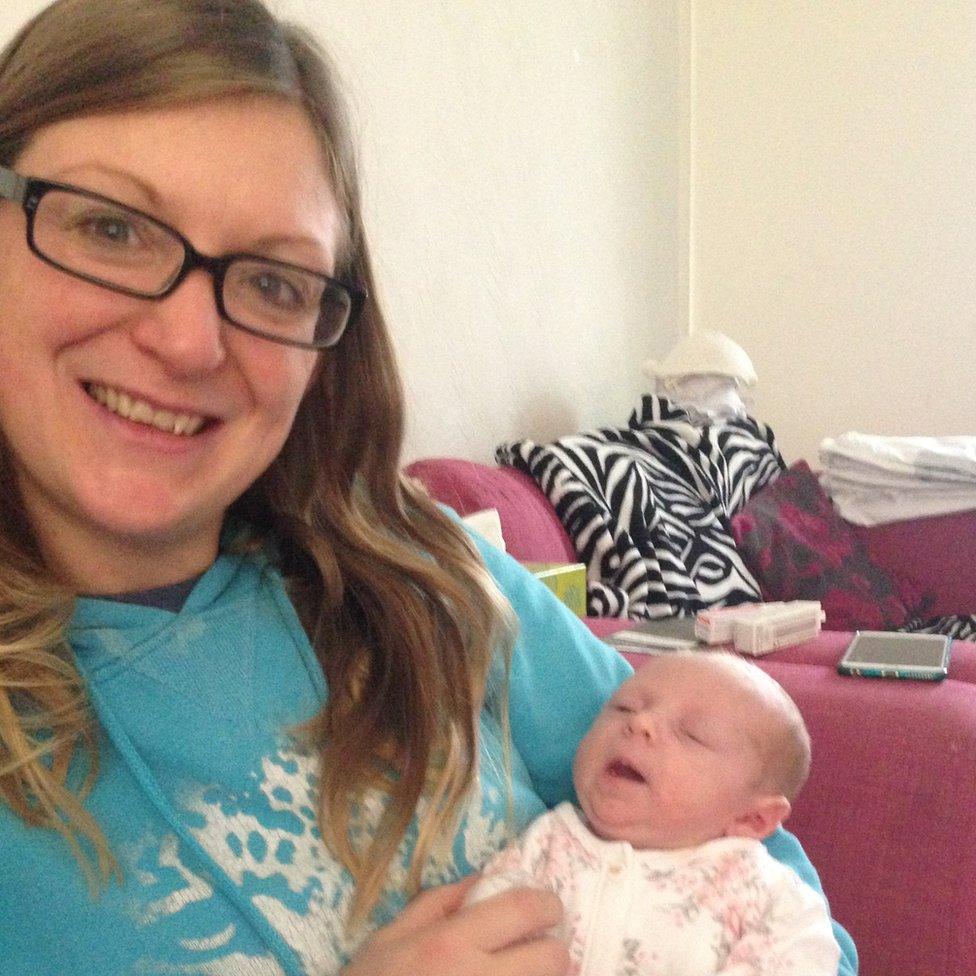
Angela Gregory says she was reassured constantly in a midwife-led unit
Angela Gregory found her labour was made a lot easier thanks to the midwives in the Royal Shrewsbury Hospital.
When her contractions started with Charlotte in November, she went to the midwife-led unit, which was the closest to her home, and found she was the only person currently in labour.
"There was always somebody with me the whole time", said the 40-year-old accountant.
When Charlotte was born, there was some concern that she was not breathing as well as she should be, due to some of the amniotic fluid having not cleared.
Mother and baby were transferred to the Princess Royal Hospital but Miss Gregory said: "Things sorted themselves out on the way there.
"I stayed in Telford for a day for a routine blood test but then went back to the midwife-led unit.
"I cannot fault the care I had at all. I was constantly reassured."
"What if something goes wrong?"

Amber Nelson is concerned in case her third baby needs extra care.
When Amber Nelson had her first two children, there were doctors on hand to help.
However if the 24-year-old opts for her nearest hospital, Horton General, for her third she will be in the care of midwives alone.
Her other option is 27 miles away at Oxford's John Radcliffe Hospital.
It is the result of a controversial move to temporarily turn the maternity unit at Horton to midwife-led, rather than consultant-led, and the change took effect in October 2016.
Miss Nelson asked: "If everything is normal then I should be able to stay at the Horton, but what if something goes wrong?
"I really want to stay local. Medically I'm fine but on past experience I might need a doctor there.
"That's not the midwives' fault at all, they're always brilliant. You can just never be 100% sure."
"Weighing up my options"
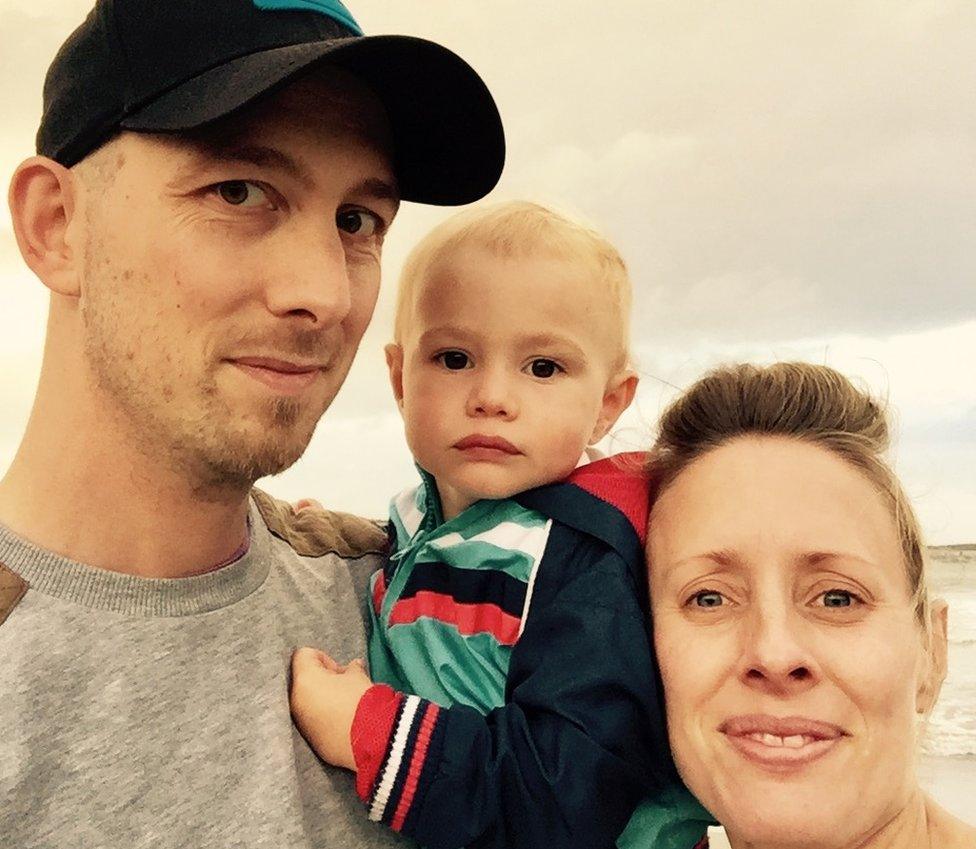
Emma Hyatt, pictured with husband Oli, needed care from a consultant when she had Bugsy.
Classed as "low risk", Emma Hyatt can choose to have her second child at the same hospital where her son Bugsy was born.
The difference this time, however, is there will be no consultants there. Following the downgrade of Horton General Hospital's maternity department to a midwife-led unit, if something happens that requires consultant care she may have to go to John Radcliffe Hospital in Oxford, 27 miles away.
Another option is to go to Warwick Hospital, which is 22 miles away along the M40.
Mrs Hyatt's experience with Bugsy, which saw her in labour for 20 hours and require medical intervention, leaves her with a choice to make before she is due to give birth in February.
"I don't have any concerns about midwife-led units at all," said the 40-year-old from King Sutton, who works as head of events marketing for a charity.
"I haven't made my decision yet, but I have to weigh up how long it will take for me to access pain relief and other intervention, if I need."
Oxford University Hospitals NHS Foundation Trust said that between 3 October and 5 December there were 35 births at the Horton and four transfers of women in labour to the John Radcliffe Hospital.
It said "in the context of a national shortage of suitably qualified doctors, the trust was not able to recruit enough doctors to fill the rota (for the Horton), and it became necessary to take a decision as to whether obstetric-led maternity services could safely be maintained".

Maureen Treadwell, co-founder of the Birth Trauma Association, said expectant parents needed more information on the options available.
She said: "Even when someone is deemed to be low risk, something can still go catastrophically wrong.
"[Midwife-led units] are recommended but there simply isn't the data to support that recommendation for first time mothers.
"We are not saying that they are not safe, just that we cannot say for certain."
Greater satisfaction
The Royal College of Midwives (RCM) said a "definitive" study had found midwife led care was as safe as a hospital birth and reduced intervention rates.
Louise Silverton, its director for midwifery, said: "Only those women without risk factors fit the criteria for birth in a freestanding unit. They have to give consent and this includes understanding the distance to hospital if transfer is needed.
"However, without the freestanding unit, the women would have needed to travel to the hospital for labour anyway. It is just that a smaller proportion of women will need to travel with the majority giving birth in the freestanding unit.
"Those women who do need to be transferred do so further on into their labour than women who have decided to have their baby in hospital. It should also be stressed that the vast majority of transfers are not urgent, and are done in planned and very controlled circumstances."
She added: "I hear from women all over the UK about their birth experiences and they often report greater levels of satisfaction with midwifery units than receiving care in traditional labour wards."
The longest transfer identified in the BBC's research was 60 miles for women giving birth at Berwick Infirmary in Northumberland. The centre is one of the smallest in England, and only 16 women started their delivery there in 2015-16. However, four had to be transferred. The Northumbria Healthcare NHS Foundation Trust's consultants based at Northumbria Hospital in Cramlington.
They also have the option to go across into Scotland to Borders General Hospital, which is 39 miles away.
Janice McNichol, head of midwifery at Northumbria Healthcare NHS Foundation Trust, said the majority of women did not require a transfer.
"The very nature of childbirth, however, means that every woman's experience is different and there are always times when unexpected complications can occur," she said.
In Oswestry in Shropshire, women using the maternity unit at Robert Jones and Agnes Hunt Hospital would be transferred 34 miles to the Princess Royal Hospital in Telford or 13 miles to Wrexham Maelor Hospital, over the Welsh border.
Women using the maternity unit at Ludlow Hospital face a journey of either 31 miles to Telford or 26 to Hereford.
The trust running both the Oswestry and Ludlow sites, Shrewsbury and Telford Hospital NHS Trust, was unable to say how many women required transfer, but said it was a transfer rate of between 20 and 25%.
An NHS England spokesman said: "It is safer than ever to give birth in this country and the vast majority of mothers report that they received great NHS care."

Why do women get transferred from midwife-led units?
Complications that can require a woman in labour to be transferred include:
Failure to progress
Fetal distress
Meconium-stained liquor (baby had a bowel movement)
Request for epidural
Hypertension
Malposition
Malpresentation
Antepartum haemorrhage
Postpartum haemorrhage
Retained placenta
Repair of perineal trauma

- Published10 August 2016

- Published13 May 2014
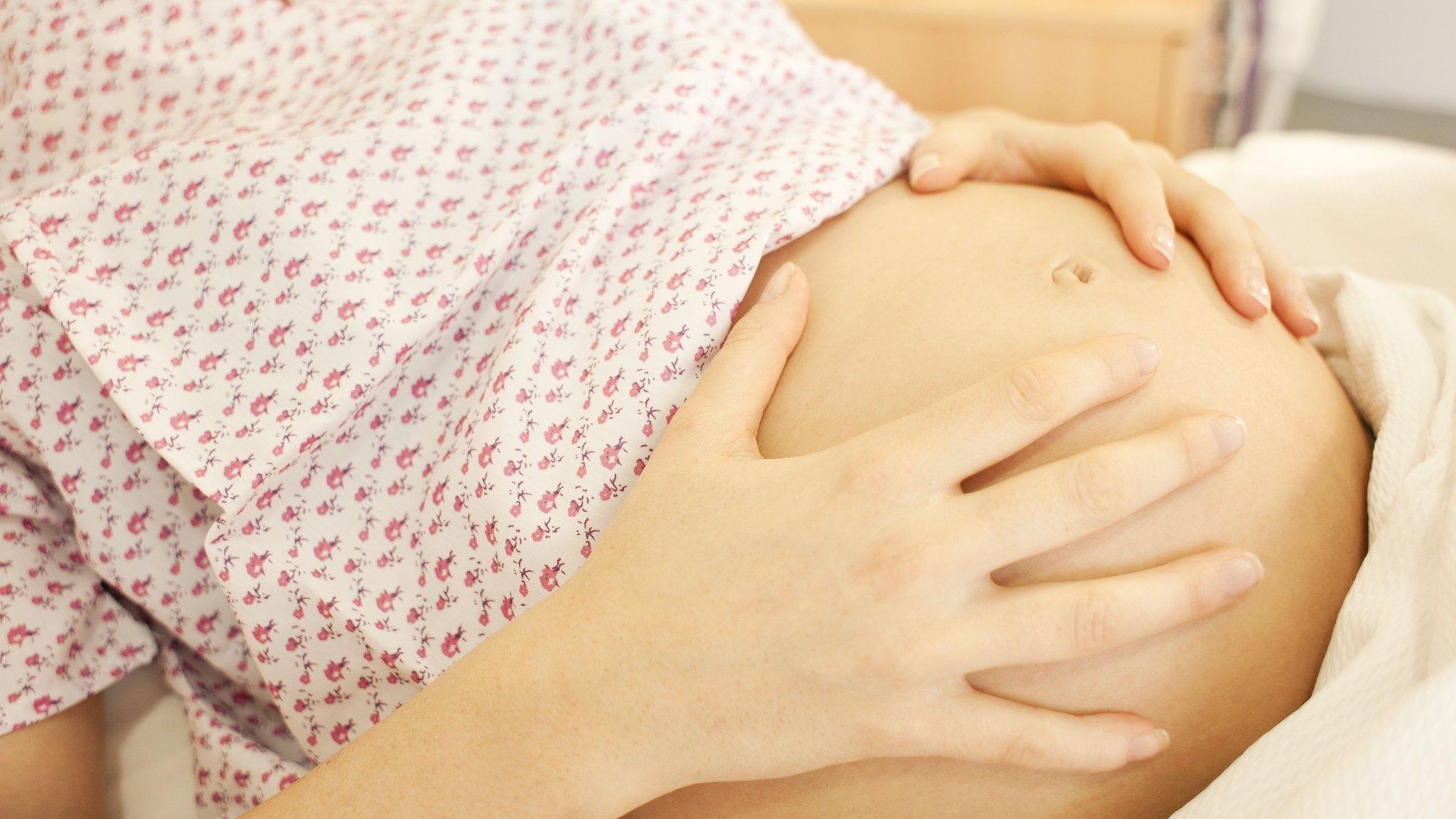
- Published24 September 2016
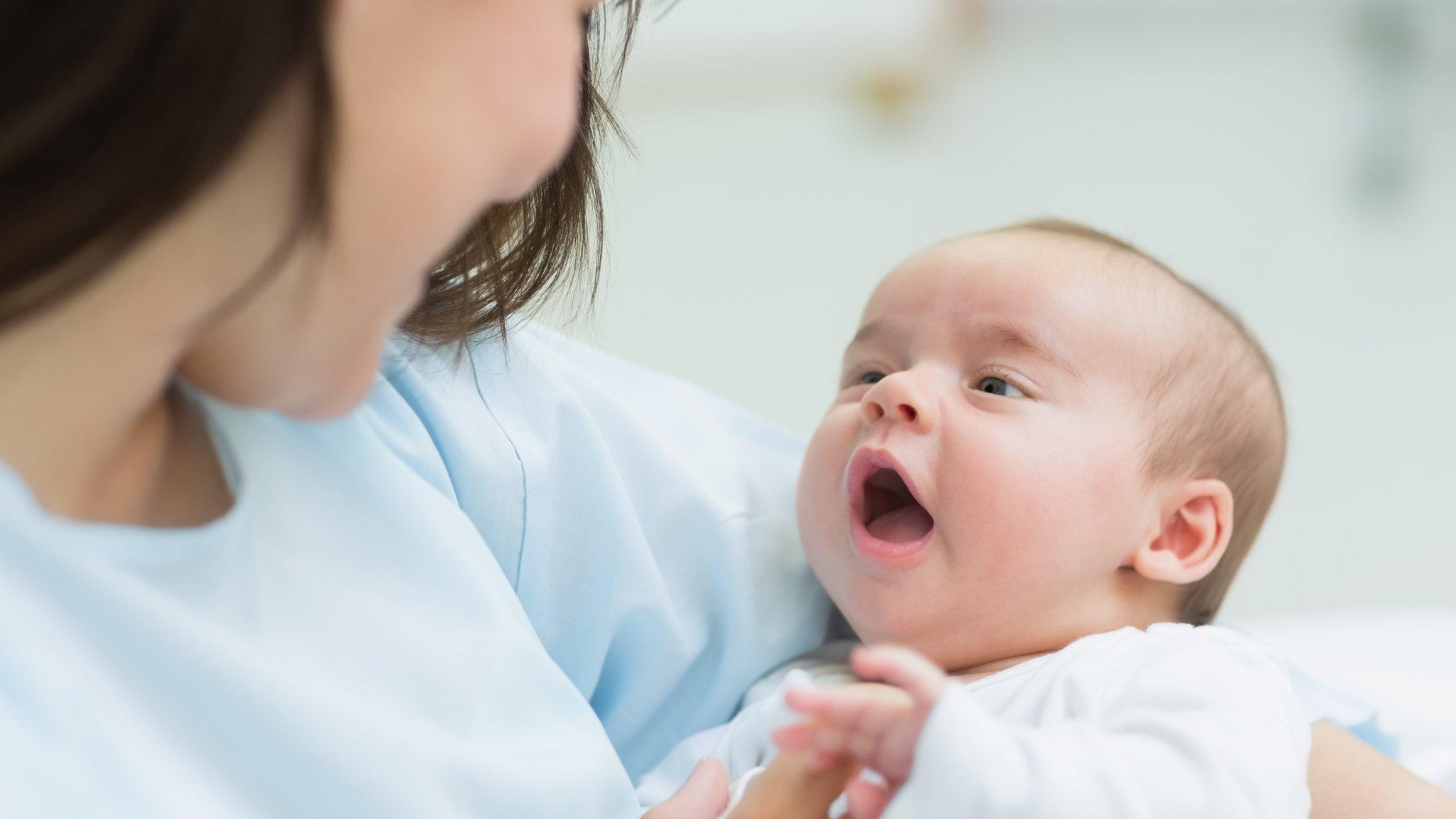
- Published9 March 2016
